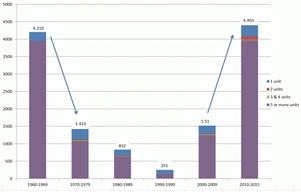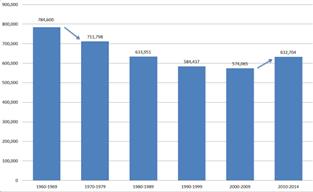District, Measured by Peter Johansson
The U.S. Census Bureau defines a building permit as the approval given by a local jurisdiction to construct new privately owned housing units.
Because building permits precede construction, they are often seen as a leading indicator for the residential construction industry. Most of the construction begins the same month the permit is issued and the remainder usually begins during the next three months. Since the housing market is also believed to be one of the first economic sectors to rise or fall when economic conditions improve or degrade, building permits are often used as an indicator for the economy as a whole.
The number of building permits issued in the District has fluctuated substantially over the last 50 years. During the District’s most expansive years in the early 1960’s population grew rapidly and construction of residential buildings reached historic highs. Things took a turn in the latter part of the 1960’s, as fewer people chose to live in the District and fewer permits were being issued. This negative trend sustained for decades, until the turn of the century. Now we once again seem to be heading towards record high residential construction in the District.
Figure 1: Annual Number of Building Permits (Average per Decade) Issued in the District 1960-2015

Figure 2: Population (Average per Decade) in the District 1960-2014

Conclusion: The District is currently experiencing its most expansive phase since the 1960’s, with regards to both population and construction of new residential buildings (measured by building permits). More permits are being issued than ever before and population has now reached the levels of the late 1970’s. This may very well be an indication of a strong, growing economy in the District in the years to come.
What exactly is the data?
Building permit data is from the United States Census Bureau (www.census.gov). Population data is from the Bureau of Economic Analysis (www.bea.gov).


